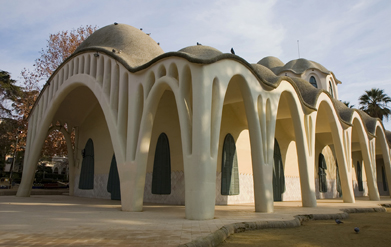Module 4 Summary
| Site: | MoodleHUB.ca 🍁 |
| Course: | Math 20-1 SS |
| Book: | Module 4 Summary |
| Printed by: | Guest user |
| Date: | Thursday, 4 December 2025, 2:08 AM |
Description
Created by IMSreader
1. Module 4 Summary
Module 4 Summary

iStockphoto/Thinkstock
The parabola has been used by architects of present and past to evoke awe and to symbolize majesty. The Masia Freixa, shown in the photo, is a modernist building located in the Spanish region of Catalonia.
Originally built in 1896 as a residence, the Masia Freixa presently serves as the meeting house for the local music society. The building is distinguished by its multiple parabolic arches and rippling grey roof. The shape of the windows is also parabolic and contributes to the overall theme.
Besides their obvious manifestation in architecture as parabolas, quadratic functions can also be used to solve problems related to building and design. Quadratic equations, quadratic inequalities, and systems of linear-quadratic and quadratic-quadratic equations were used to model and solve such problems in Module 4.
In this module you investigated the following questions:
- How are quadratic equations and inequalities used to solve problems in design and architecture?
- Why is it important to be able to solve a problem using a variety of different strategies?
In the first part of the module you learned how to solve quadratic equations using a variety of strategies. You used quadratic equations to determine the footprint of a building, the width of a tile border around a swimming pool, and the dimensions of a dog run.
In the second part of the module you used quadratic systems to solve a problem related to the design of a store sign, and to find the intersection of two streams from a fountain. You also used quadratic inequalities to model problems dealing with solar-panel areas and price-to-cost ratios in carbon-neutral homes.
Throughout this module you learned multiple ways to solve quadratic equations, their systems, and inequalities. You may have discovered through discussions with your peers that different people may prefer different strategies.
You may have also discovered that the strategy you choose to address a problem often depends on the nature of the parameters in the problem. For example, a quadratic equation with decimal coefficients may best be solved with a graphing technique.
Module 4: Quadratic Equations and Inequalities, Video Summary is a look back at the math you explored. Watch Module 4: Quadratic Equations and Inequalities, Video Summary to review what you learned and to confirm your answers to the module questions.
The following table summarizes the learning outcomes in Module 4. Complete a table like this one by listing the activities you undertook to address each outcome. You can use Module 4: Quadratic Equations and Inequalities, Video Summary to help you recall major activities. You can also revisit the lessons.
| Outcomes for This Module | Learning Activities in Which I Addressed This Outcome |
factor polynomial expressions of the form |
|
factor polynomial expressions of the form |
|
| solve problems that involve quadratic equations | |
| graphically solve problems that involve systems of linear-quadratic and quadratic-quadratic equations in two variables | |
| algebraically solve problems that involve systems of linear-quadratic and quadratic-quadratic equations in two variables | |
| solve problems that involve linear and quadratic inequalities in two variables | |
| solve problems that involve quadratic inequalities in one variable |
![]() Save a copy of your completed table in your course folder for review.
Save a copy of your completed table in your course folder for review.
